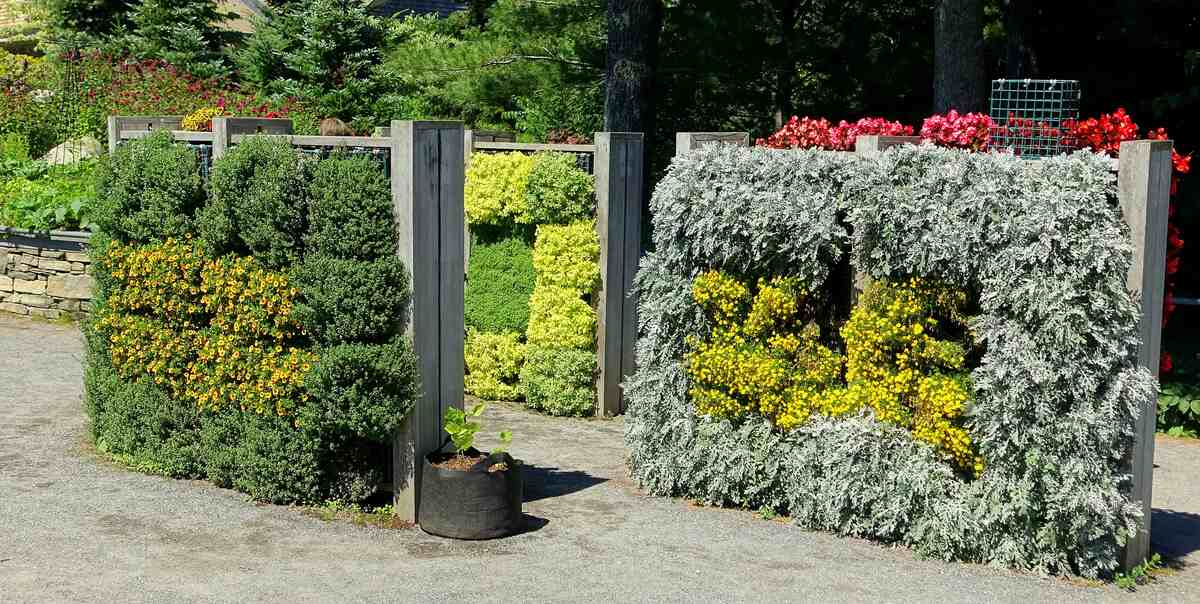
When tethered to the ground, dreams will never have the chance to soar, which also goes for the big dreams you have for your garden. Don’t let limited space on land keep your plant plans on hold. Try these 12 vertical gardening ideas, and transform walls, trellises, fencing, balconies, and arbors to turn your small space into an outdoor paradise.
- What is Vertical Gardening?
- 12 Vertical Gardening Design Ideas
- 1. Trellises for Vining Plants
- 2. Green Walls of Container Plants
- 3. Hydroponic Living Walls
- 4. Pallet Planters for Herbs and More
- 5. Build a Gutter Garden
- 6. Stacked Cinder Block Gardens
- 7. Tower Gardens for Edible Plants
- 8. Create Visual Interest with Hanging Pots
- 9. Pyramid-Shaped Raised Beds
- 10. Recycled Vertical Garden
- 11. Privacy Fence Garden
- 12. Ladder Planter Garden
- Vertical Gardening: Other Things to Know
- FAQ: About Vertical Gardens
What is Vertical Gardening?
Vertical gardening is just as it sounds — arranging various types of plants in such a way that they grow up (or vertically). This is done in many ways. You can install pots along shelves on an exterior wall, hook hanging baskets on windowsills, or train climbing plants to ascend trellises, railings, pergolas, or other freestanding structures.
Need some inspiration? Take a look at 12 vertical garden design ideas to spruce up your small space.
12 Vertical Gardening Design Ideas
1. Trellises for Vining Plants

Typically adorned with mesh lattice, trellises are frames made to support the growth of climbing plants. They come in various materials to suit your budget — wood, heavy plastics, wire, and metal. You can affix them to an exterior wall, leave them freestanding to lean against another structure or try one of these trellis ideas.
Experts at the University of Minnesota Extension recommend planting vines at the base of the trellis, weaving them in and out of the mesh while young to train them to grow upward. Leave the appropriate growing space between plants as in any other garden setting.
Advantages of planting on a trellis:
- Produces more high-quality fruits and veggies
- Prevents problems with pests and diseases
- Maximizes garden space
- Provides accessibility for people of all ages and abilities; no need for bending
Maintenance: Trellises may require replacing building components such as wood, wire, and metal from time to time, as each can decay after a few years.
Repainting wood, pruning back dead vines, and maintaining the ground area clear of leaves and debris are all examples of upkeep.
Cost: On average, a trellis costs between $50 and $135 per linear foot. The material it’s made from has the biggest influence on its price.
To cut the cost of wood, build a trellis using branches from trees in your yard instead. Ready-made trellises can range in price from $12 to $100, depending on the size and materials used.
The best vining plants to grow on a trellis:
Fruit
- Blackberries (Rubus)
- Grapes (Vitis)
- Raspberries (Rubus idaeus)
Flowers
- Clematis (Clematis)
- Honeysuckle (Lonicera periclymenum)
- Morning glories (Ipomoea purpurea)
Herbs
- Nasturtium (Tropaeolum majus)
- Passion Flower (Passiflora incarnata)
- Star Jasmine (Trachelospermum jasminoides)
Vegetables
- Cucumbers (Cucumis sativum)
- Melons (watermelon and cantaloupes)
- Pole beans (Phaseolus vulgaris)
2. Green Walls of Container Plants

The perfect weekend DIY project, these green walls act as a form of container gardening — affix pots or wall planters to fencing, your home’s exterior wall, or a freestanding structure. For an easy route, purchase an instant living wall online.
Pots (or other containers of your choice) make it easy to grow just about any plant, whether you’re starting a flower garden, herb garden, vegetable garden, succulent garden, or a mix of each.
If your container wall is indoors, look for self-pollinating varieties or learn how to pollinate your plants manually. Perennials and herbs work well in this vertical garden system.
Advantages of container planters:
- Easy to set up
- Adds beauty and interest
- No weeding is needed
- Changing up plants and pots is easy and quick
- Individual plant care is more accessible than in an in-ground setting.
Maintenance: Caring for living wall container gardens requires frequent watering (once or twice a day) and fertilizing (about every two weeks). It’s important to deadhead blooms as needed and switch out types of plants with each new season.
Cost: Many factors go into building a living wall: weight, size, materials, and plans. You can buy one ready-to-go for $30 to $80 (not including plants) or build your own.
The best plants to grow in container planters:
Fruits
- Citrus (varieties of oranges, lemons, and limes)
- Figs (Ficus carica)
- Alpine Strawberries (Fragaria vesca)
Flowers
Herbs
- Basil (Ocimum basilicum)
- Cilantro (Coriandrum sativum)
- Rosemary (Salvia rosmarinus)
Vegetables
- Broccoli (Salvia rosmarinus)
- Eggplant (Solanum melongena)
- Tomato (Solanum lycopersicum)
3. Hydroponic Living Walls
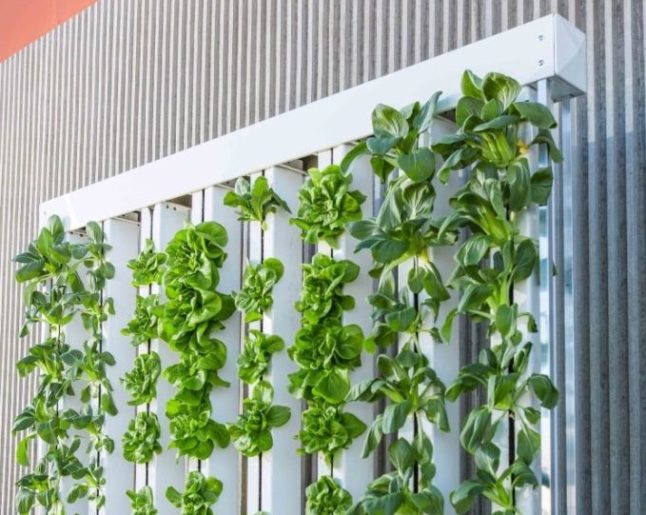
Using nutrient-rich water instead of soil (a process known as hydroponics), a less boxy style of the green wall can grow. Hydroponic gardens can also be grown inside piping, towers, and gutters.
Systems for watering living walls might be cheap DIY drip irrigation using PVC pipes or as sophisticated as an expensive automated water recirculation system. Keep in mind the weight and water needed when building a hydroponic wall.
Advantages of hydroponic living wall:
- Creates more interest that increases property value
- No soil-borne diseases
- Reduces stress/anxiety; promotes overall well-being
- Lowers energy bills by up to 20%
- Reduces air, water, and noise pollution
- No weeding necessary
- Provides shade in summer, insulation in winter, and helps mitigate stormwater runoff
Maintenance: Vertical gardens that use hydroponics require very little upkeep. You only need to check on your plants every few days to ensure everything is operating as it should because they have their own irrigation system.
Check for pests like aphids, thrips, and spider mites. Add water every few days as needed, and change the nutrient basin about once per month. Root rot is a common issue and something to watch for.
Cost: Experts typically design and build this type of living wall. Prices range from $500 to $2,000, depending on size, difficulty, and plants selected. Or opt for a less expensive, low-maintenance DIY version made from preserved moss.
Best plants to grow in a hydroponic living wall:
Fruits
- Currants (Ribes)
- Strawberries (opt for a day-neutral variety for hydroponics)
- Watermelons (Citrullus lanatus)
Flowers
- Impatiens (Impatiens)
- Petunias (Petunia)
- Wallflowers (Erysimum cheiri)
Herbs
- Chives (Allium schoenoprasum)
- Parsley (Petroselinum crispum)
- Sage (Salvia officinalis)
Vegetables
- Bell Peppers (Capsicum annuum)
- Lettuce (Lactuca sativa)
- Spinach (Spinacia oleracea)
4. Pallet Planters for Herbs and More

Into upcycling? Consider building a pallet planter. It won’t take up a lot of space, and your new DIY vertical pallet garden can be ready to use in no time.
Place pots or planter boxes inside the pallet, attach them to slats or grow plants directly inside. Pallet planters can be used as edible gardens, provided the wood is safe. Pallets are a good choice for a vertical herb garden you can grow close to the kitchen.
Advantages of a pallet planter garden:
- Helps the environment through repurposing
- Budget-friendly; you can find pallets for free or very low cost
- Easy to assemble (pallet is already made)
- No weeding necessary
Maintenance: Check soil moisture often and water as needed. Like other container gardens, this one can lose moisture quickly. Trim plants back as needed. As with any garden or landscaping project, keep in mind pests and diseases. An Integrated Pest Management (IPM) system will save you time and trouble.
Cost: You can get free pallets at your local grocery, hardware store, or lumberyard. You’ll need some other supplies, including a circular saw, landscape fabric, staple gun, potting soil, and, of course, plants. In total, expect to pay $50 to $200, depending on whether you already have a circular saw.
Tall plants, such as tomatoes, should be planted in the top row of your garden. The bottom works best with vining plants, such as cucumbers, while the middle fits better with compact plants, such as herbs, for the perfect pizza garden.
The best plants to grow in a pallet planter garden:
Fruits: Pallet gardens don’t leave much room for growing fruit.
- Strawberries
Flowers
- Begonias (Begonia)
- Petunias (Petunia × Atkinson)
- Succulents
Herbs
- Oregano (Origanum vulgare)
- Parsley (Petroselinum crispum)
- Peppermint (Mentha × Piperita)
Vegetables
- Arugula (Eruca sativa)
- Cherry tomatoes (Solanum lycopersicum var. cerasiforme)
- Summer squash (Cucurbita pepo)
5. Build a Gutter Garden

Another type of container gardening is repurposing old gutters or buying them new. PVC pipe will work, too, but you should not grow edible plants in PVC pipes, as chemicals may leach into the soil.
Gutter gardening is not only ideal for those living in small places but also a perfect gardening project for kids. Because of its modest size and ease of installation at a suitable height, this little landscape is perfect for a young gardener.
Mount the gutters or pipes on your wooden fence, a trellis, an exterior wall, your deck railings, or a freestanding structure. You can also choose to hang them — drill holes into the bottom of these planters to ensure proper drainage.
Advantages of a gutter garden:
- Eco-friendly (and economical) if repurposing old gutters
- Space-saving
- No bending necessary to tend to plants
- No need to weed
- Versatile designs
- Works as a piece of art and a garden
- Keeps plants out of reach of animals
Maintenance: The soil in container gardens tends to dry out quickly since there’s no connection to moisture from the ground. Be sure to water daily. You can buy or make automatic waterers to save time and work. Fertilize frequently and replace the soil after each growing season.
Cost: If you have all the supplies available, then the only cost is the plants. The average cost for gutters is $4 per linear foot.
The best plants to grow in a gutter garden:
Fruits: Not a great option for fruit, but gutter gardens are an option for growing edible flowers.
- Lavender (Lavandula angustifolia)
- Pansies (Viola spp.)
- Strawberries (everbearing varieties are best)
Flowers
- Diamond frost (Euphorbia hybrid ‘Inneuphdia’)
- Marigolds (Tagetes erecta)
- Poppies (Papaver somniferum)
Herbs
- Cilantro (Coriandrum sativum)
- Dill (Anethum graveolens)
- Thyme (Thymus vulgaris)
Vegetables
- Beets (Beta vulgaris)
- Radishes (Raphanus sativus)
- Spinach (Spinacia oleracea)
6. Stacked Cinder Block Gardens
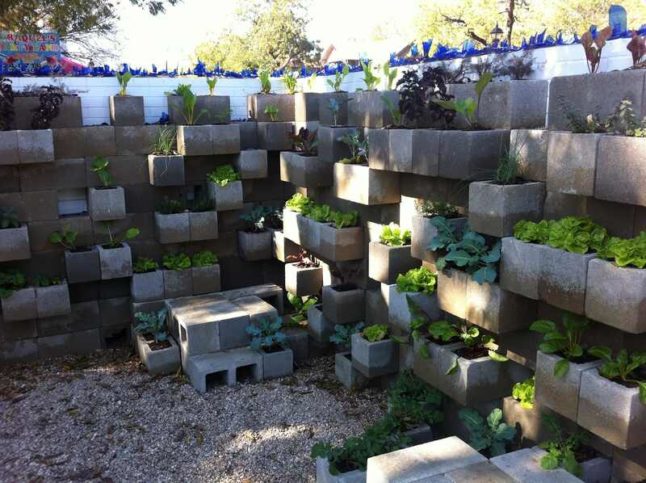
Do you like Legos? The cinder block planter is the ideal garden for you. “Cinder blocks” are concrete blocks that are stacked so that the voids in them are used as planters. The layers can be arranged in various ways to fit almost any space and height.
An overhanging lip that grabs the block below is a common characteristic of landscaping blocks. They are excellent for raised garden beds because stacking them usually doesn’t need mortar. Making damaged blocks easy to replace.
Advantages of cinder block gardens:
- Saves space
- Resistant to sun and water damage
- Cost-effective with the use of recycled materials
- Provides good drainage for the soil
Maintenance: Concrete blocks are resilient and don’t need much maintenance. As the blocks allow for good drainage and retain more heat with direct sunlight, keep an eye on your soil moisture. Make your own automatic watering system by recycling water bottles to save time.
Cost: Cinder blocks cost from $15 to $40 a square foot when bought new but are easy to recycle. You find them cheaper on local marketplaces or recycled from construction projects.
Best plants to grow in a cinder block garden:
Fruits
- Strawberries
- Not recommended for growing most fruits
Flowers
- Aster (Tripolium pannonicum)
- Lily of the Valley (Convallaria majalis)
- Primrose (Primula vulgaris)
Herbs
- Dill (Anethum graveolens)
- Garlic (Allium sativum)
- Marjoram (Origanum majorana)
Vegetables
- Carrots (Daucus carota subsp. sativus)
- Leeks (Allium porrum)
- Peas (Pisum sativum)
7. Tower Gardens for Edible Plants
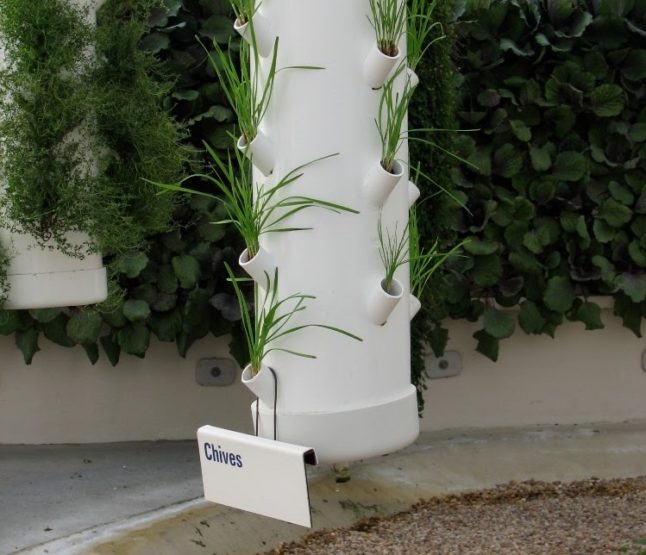
These tower-shaped planters can be used indoors or outdoors and have hydroponic (or aeroponic) systems, both of which use water only rather than soil. Able to hold several dozen plants, you can use tower gardens to grow fruits, vegetables, indoor herbs, and flowers.
Typically, a grow cage or an external structure is required for a tower garden to support the weight of the fruits.
Advantages of a tower garden:
- Depending on size, you can grow 50+ plants at a time
- No prior gardening experience needed
- Takes up little space
- Produces greater yields than traditional garden beds
Maintenance: Low. Clean the tower after each growing season. Also, monitor water levels in the tank and refill as needed.
Cost: If you’re handy and want to build your own vertical hydroponic tower, the materials cost will be about $300. Or, you can purchase a ready-made tower for up to $700.
Best plants to grow in a tower garden:
Fruits
- Cantaloupe (Cucumis melo var. cantalupensis)
- Honeydew (Cucumis melo var. inodorous)
- Strawberries (Have we mentioned strawberries?)
Flowers
- Alliums (Allium)
- Calendula (Calendula officinalis)
- Honeysuckle (Lonicera periclymenum)
Herbs
- Cumin (Cuminum cyminum)
- Rosemary (Salvia rosmarinus)
- Sage (Salvia officinalis)
Vegetables
- Chard (Beta vulgaris subsp. vulgaris)
- Kale (Brassica oleracea var. sabellica)
- Peppers (Capsicum)
8. Create Visual Interest with Hanging Pots

A quick and easy way to make your surroundings more beautiful or to fit plants into small places is to use hanging planters. Add color and texture to the ceilings and walls of decks, porches, and patios with flower-filled, lightweight hanging pots or baskets.
Incorporate climbing plants mixed with tall and clumping varieties for differences in texture and height. But don’t forget to bring your outdoor potted plants indoors before your first frost and keep them as houseplants for the winter. Trailing ivies, feathery ferns, or succulents like string of pearls make a striking green display that hangs from the ceiling to maximize your vertical space.
Advantages of a hanging pot garden:
- An improved environment can boost mood/overall wellness
- Maximizes space
- Creates a privacy screen
- Easily accessible for all ages and abilities; no bending necessary
Maintenance: Use potting mix over heavy soil and infuse it with a slow-release fertilizer. Water as needed (when the soil feels dry to the touch), and deadhead blooms weekly.
Cost: Expect to spend between $35 and $100 on hanging pots, potting mix, and flowers, depending on the size and features of containers, amount of planting material, and number of plants.
Best plants to grow in a hanging pot garden:
Fruits
- Blackberries (Rubus fruticosus)
- Dwarf blueberries (Vaccinium cespitosum)
- Raspberries (Rubus idaeus)
Flowers
- Fuschia (Fuchsia magellanica)
- Snapdragons (Antirrhinum majus)
- Verbena (Verbena officinalis)
Herbs
- Mint (Mentha)
- Lavender (Lavandula angustifolia)
- Rocket (Eruca sativa)
Vegetables
- Cabbage (Brassica oleracea var. capitata)
- Eggplants (Solanum melongena)
- Mustard greens (Brassica juncea)
9. Pyramid-Shaped Raised Beds
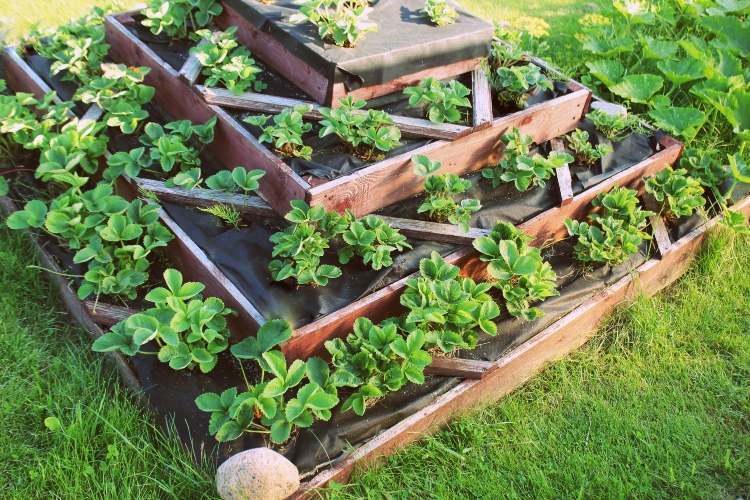
Tiered types of raised garden beds are perfect for vertical gardening. They can be built from various materials, including wood, metal, or cinder blocks. Avoid using wood that has been pressure treated in your edible gardens, as the chemicals may leach into the soil.
You can purchase a pyramid-shaped raised bed or build your own. If you’re doing DIY projects, you’ll need a saw, miter box, drill, screws, measuring tape, and a pencil, or build one with notches.
Advantages of pyramid-shaped garden beds:
- Longer growing season
- Accessible to all ages/abilities
- Adds beauty/focal point interest
- Low-maintenance; weeding isn’t necessary
Maintenance: To start your plants off right, use a mix of topsoil, compost, mulch, and peat. To make things even more low-maintenance, install a drip irrigation system to keep roots hydrated automatically.
Cost: For a kit, pre-made raised garden beds cost around $145.48. If you build one yourself, building supplies typically cost $18.39 per square foot.
Best plants to grow in pyramid-shaped garden beds:
Fruits
- Galia melon (Cucumis melo var. reticulatus)
- Muskmelon (Cucumis melo)
- Sugar baby watermelon (Citrullus lanatus)
Flowers
- Black-eyed Susans (Rudbeckia hirta)
- Hostas (Hosta x tardiana)
- Zinnias (Zinnia elegans)
Herbs
- Coriander (Coriandrum sativum)
- Lemon beebalm (Monarda citriodora)
- Tarragon (Artemisia dracunculus)
Vegetables
- Corn (Zea mays)
- Pumpkins (Cucurbita pepo)
- Zucchini (Cucumis sativus)
10. Recycled Vertical Garden

Plants are fantastic because they can thrive in almost any container with the proper amount of sunlight, moisture, and nutrients. You can establish an original vertical garden from recycled materials using anything from old shoe organizers to paint cans to soda bottles to old dressers, chests of drawers, or nightstands.
The drawers of old furniture also make the perfect planting beds for flowers or small fruit trees. Hang a shoe organizer or other pocket-style piece from an exterior wall of your home, or mount bottles and cans to your fence. You can reuse milk jugs as hanging baskets.
Advantages of recycled gardens:
- Eco-friendly, as it reuses items rather than discarding them
- Accessible for all ages/abilities
- Brings distinctive beauty to a small garden
- No weeding necessary
- Budget-friendly
Maintenance: Caring for plants in a repurposed vertical garden is similar to caring for those in other container gardens. Water and fertilize as necessary, with appropriate sunlight, and deadhead blooms once they’ve finished blooming.
Cost: A garden like this will mainly come from the stuff you have around. You’ll only need to spend money on potting mix and plants. How much you’ll spend depends on the number of plants you’ll need to fill out the container. Prices can range from $30 to more than $100.
Best plants to grow recycled gardens:
Fruits
- Blackberries (Rubus subg. Rubus)
- Dwarf citrus trees (Citrus limon x ‘Meyeri)
- Raspberries (Rubus idaeus)
Flowers
- Ferns (Tracheophyta)
- French marigolds (Tagetes patula)
- Impatiens (Impatiens walleriana)
Herbs
- Bay laurel (Laurus nobilis)
- Garlic (Allium sativum)
- Lemongrass (Cymbopogon citratus)
Vegetables
- Bell peppers (Capsicum annuum)
- Bok choy (Brassica rapa subsp. chinensis)
- Tomatoes (Solanum lycopersicum L)
11. Privacy Fence Garden
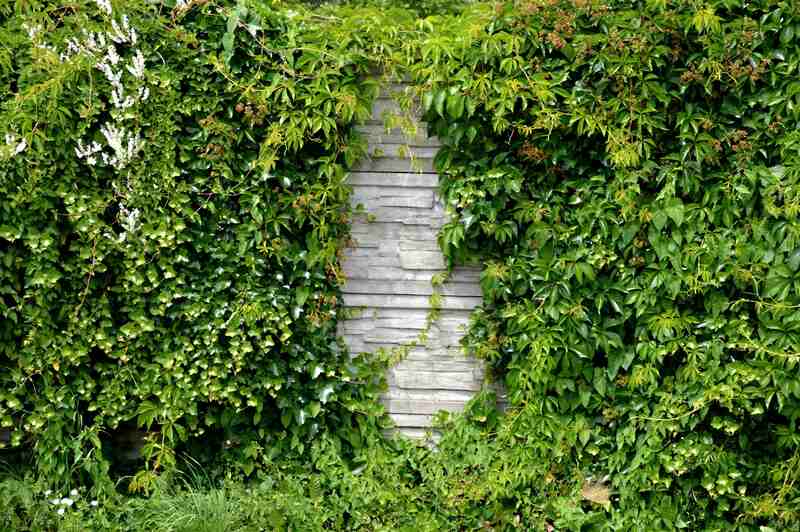
Brighten up the look of a privacy fence with hanging or mounted pots, bottles, cans, or planter boxes. Not only can the flowers and greenery level up the color and texture in your backyard, but the varying hues and materials of the containers make your fence look more welcoming.
Using your privacy fence to grow plants opens up a new world of possibilities, like espaliering your fruit trees. Climbing vines are easy to grow on a fence and look stunning. Consider planting hops if you’re into brewing your own craft beer.
Advantages of a privacy fence garden:
- Beautifies your outdoor spaces
- Ensures gardening is accessible to all ages and abilities
- No weeding necessary; no worries about the foot traffic and erosion
- Saves space
Maintenance: Containers like these make it easier to care for individual plants and can be low or high-maintenance, depending on the type of flower, vegetable, herb, or fruit you are growing.
Water as needed (when the soil feels dry) and fertilize every few weeks (unless you’re caring for succulents). Flowering plants may also need periodic deadheading.
Cost: Reused pots, bottles, and cans will cost you nothing, but if you’re looking to purchase new containers, plan to spend around $40 or $50 for pots, soil mix, and plants.
Best plants to grow in a privacy fence garden:
Fruits
- Apples (Malus pumila)
- Grapes (Vitis vinifera)
- Pears (Pyrus communis L)
Flowers
- Climbing roses (Rosa setigera)
- English ivy (Hedera helix)
- Morning glories (Ipomoea purpurea)
Herbs
- Anise hyssop (Agastache foeniculum)
- Hops (Humulus lupulus)
- Jasmine (Jasminum)
Vegetables
- Pole beans (Phaseolus coccineus)
- Snow peas (Pisum sativum var. saccharatum)
- Squash (Cucurbita)
12. Ladder Planter Garden

Another upcycling idea: Transform an old ladder into a vertical garden. The rungs can hold individual pots and planter boxes and can be displayed anywhere — in your side yard, in the corner of your deck, or to spruce up the backyard.
Ladder garden planters are an ideal alternative for a small yard or balcony. The design keeps the plants safe and fresh herbs close at hand in less space. If you already have a wooden step ladder, you can reuse it or build one from scratch using cedar wood.
Advantages of ladder planter garden:
- No building experience is necessary
- Maximizes space
- Easily accessible for all ages and abilities
- Creates visual interest
- Repurposes a no longer used item
Maintenance: Water and fertilize container plants when needed. Once the growing season has ended, depending on your hardiness zone, replace the soil in the containers before planting for the new season. Some flowering varieties may need occasional deadheading.
Cost: As the ladder is something you may already have around the house, that will cost you nothing. Containers and plants can range from around $50 to more than $100.
Best plants to grow in a ladder planter garden:
Fruits
- Gooseberries (Ribes uva-crispa)
- Grapes (Vitis)
- Sugar Cube Cantaloupe (Cucumis melo var. cantalupensis)
Flowers
- Coral bell (Heuchera americana)
- Yellow archangel (Lamiastrum galeobdolon)
- Pincushion flower (Scabiosa)
Herbs
- Chives (Allium schoenoprasum)
- Fennel (Foeniculum vulgare)
- Rosemary (Salvia rosmarinus)
Vegetables
- Broccoli (Brassica oleracea var. italica)
- Cauliflower (Brassica oleracea var. botrytis)
- Spinach (Spinacia oleracea)
Vertical Gardening: Other Things to Know
What are the Benefits of Vertical Gardening?
Vertical gardening provides easier access to your harvest, reduces the need to do so much bending, and helps maximize your space. Other benefits include:
- Better air movement between plants
- Energy efficiency as your garden can block sunlight on hot days and insulate on cooler ones
- Reduces stormwater runoff by soaking up rainfall before it hits the ground
- Lessens the risk of diseases since your garden is not in the ground
- Can act as a windbreak and privacy screen
FAQ: About Vertical Gardens
Yes. Succulents are an excellent choice for any vertical garden or living wall. DIY projects are made from a shadow box or other deep-set picture frame. Good options for succulents include:
● Pachyveria blue pearl (Echeveria x Pachyphytum)
● Mother of pearl plant (Graptopetalum superbum paraguayense)
● Moon silver succulent (Pachyphytum oviferum)
Are Vertical Gardens High Maintenance?
No. Vertical gardens tend to be lower maintenance than a traditional garden bed, plus they have the bonus of accessibility for different ages and abilities. They also tend to have fewer issues with diseases and pests.
Any vertical garden can benefit from a high-quality potting soil mix. To make suitable soil at home, combine equal amounts of compost or peat moss, topsoil or loam, and builder’s sand.
When to Call a Landscaping Pro
Most vertical gardens are extremely doable DIY projects. But if you’re hoping to try a more complicated system, such as hydroponics, the help of an expert comes in handy to ensure things are installed correctly and run smoothly.
Contact a local professional landscaper who can also lend their skills toward helping you create a vertical garden design you’ll enjoy. Then, you can head to your local garden center, pick out the plants, and install them yourself.
Main Image Credit: Daderot / Wikimedia Commons / CC0 1.0